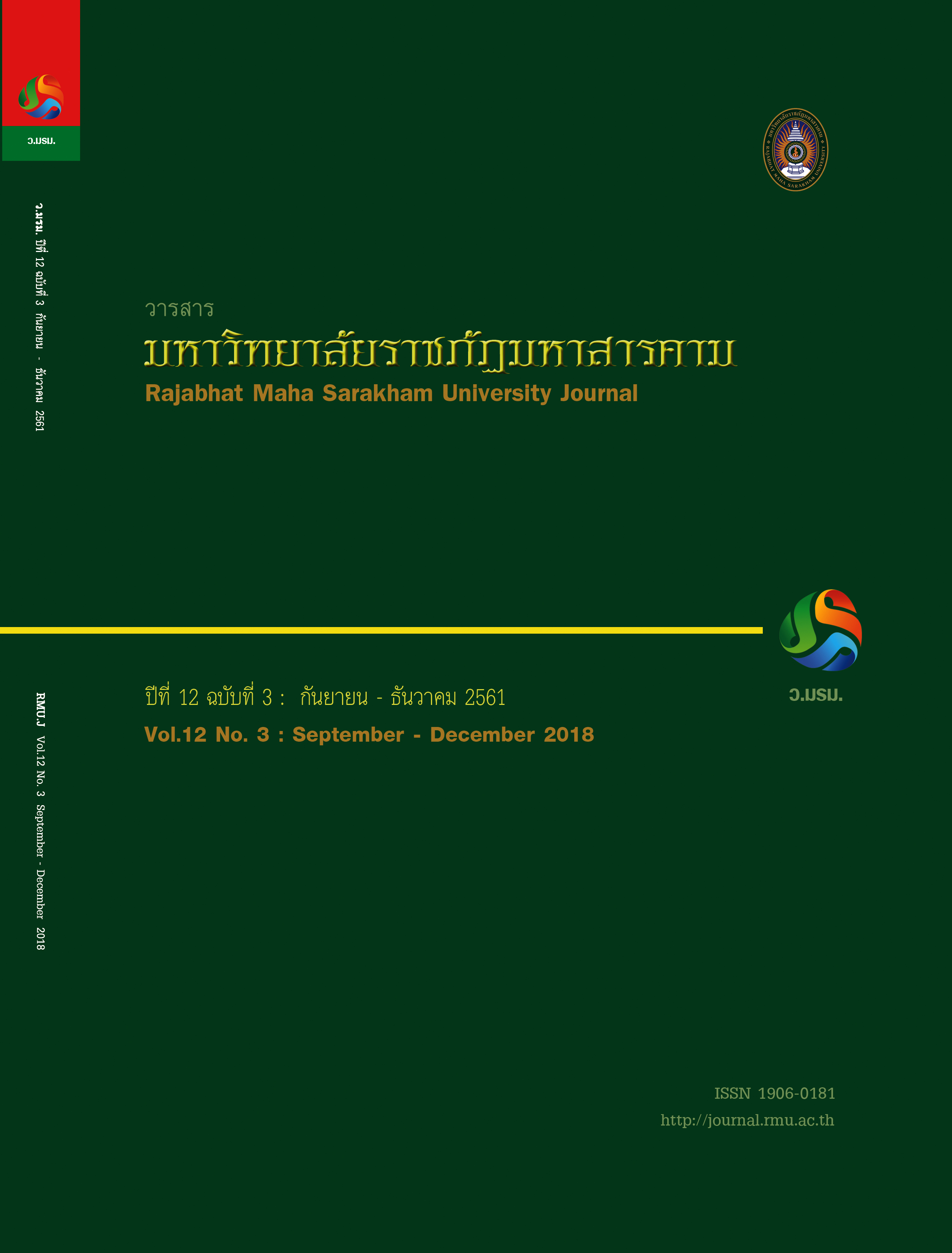ปัจจัยที่มีอิทธิพลต่อความรอบรู้ด้านสุขภาพของนักเรียนระดับมัธยมศึกษาสำนักงานคณะกรรมการการศึกษาขั้นพื้นฐาน ในภาคตะวันออกเฉียงเหนือ :การวิเคราะห์กลุ่มพหุ
Main Article Content
บทคัดย่อ
การวิจัยครั้งนี้มีวัตถุประสงค์เพื่อ 1) พัฒนาตัวบ่งชี้ความรอบรู้ด้านสุขภาพของนักเรียนระดับมัธยมศึกษา ในภาคตะวันออกเฉียงเหนือ 2) เพื่อพัฒนาและตรวจสอบความตรงของโมเดลปัจจัยที่มีอิทธิพลต่อความรอบรู้ด้านสุขภาพของนักเรียนระดับมัธยมศึกษาในภาคตะวันออกเฉียงเหนือ และ 3) เพื่อวิเคราะห์ความไม่แปรเปลี่ยนของโมเดลและค่าพารามิเตอร์ในโมเดลปัจจัยที่มีอิทธิพลต่อความรอบรู้ด้านสุขภาพของนักเรียนระดับมัธยมศึกษาในภาคตะวันออกเฉียงเหนือ ระหว่างนักเรียนชั้นมัธยมศึกษาตอนต้นกับนักเรียนชั้นมัธยมศึกษาตอนปลาย และระหว่างนักเรียนที่โรงเรียนอยู่ในเขตเมืองกับนอกเขตเมือง โดยประยุกต์ใช้การวิเคราะห์กลุ่มพหุ กลุ่มตัวอย่างคือ นักเรียนระดับมัธยมศึกษาในภาคตะวันออกเฉียงเหนือ จำนวนทั้งสิ้น 1,799 คน เครื่องมือที่ใช้ในการวิจัยประกอบด้วย แบบสอบถามวัดปัจจัยที่มีอิทธิพลต่อความรอบรู้ด้านสุขภาพ 3 ปัจจัย มีค่าความเชื่อมั่นอยู่ระหว่าง 0.58 - 0.76 แบบวัดความรู้ความเข้าใจด้านสุขภาพ และ แบบวัดทักษะการเข้าถึงสารสนเทศด้านสุขภาพมีค่าความยากอยู่ระหว่าง 0.27 - 0.80 มีค่าอำนาจจำแนกอยู่ระหว่าง 0.20 –0.57 และค่าความเชื่อมั่นเท่ากับ 0.92 แบบวัดทักษะการสื่อสารด้านสุขภาพ ทักษะการใช้สารสนเทศด้านสุขภาพ และ ทักษะการตัดสินใจด้านสุขภาพ มีความเชื่อมั่นอยู่ระหว่าง 0.53 ถึง 0.85 การวิเคราะห์ข้อมูลใช้ สถิติเชิงบรรยาย การวิเคราะห์ค่าสัมประสิทธิ์สหสัมพันธ์ การวิเคราะห์องค์ประกอบเชิงยืนยัน การวิเคราะห์โมเดลสมการโครงสร้าง และการวิเคราะห์กลุ่มพหุ ผลการวิจัยพบว่า (1) โมเดลการวัดความรอบรู้ด้านสุขภาพของนักเรียนระดับมัธยมศึกษา ประกอบด้วย 5 ตัวแปร คือ ความรู้ความเข้าใจด้านสุขภาพ (KNO) ทักษะการเข้าถึงสารสนเทศด้านสุขภาพ (ACC) ทักษะการสื่อสารด้านสุขภาพ (COM) ทักษะการใช้สารสนเทศด้านสุขภาพ (USE) และ ทักษะการตัดสินใจด้านสุขภาพ (DEC) โดย ตัวแปรความรู้ความเข้าใจด้านสุขภาพ (KNO) มีค่าน้ำหนักองค์ประกอบสูงที่สุด รองลงมาคือ ตัวแปรทักษะการตัดสินใจด้านสุขภาพ (DEC) ตัวแปรทักษะการเข้าถึงสารสนเทศด้านสุขภาพ (ACC) ตัวแปรทักษะการสื่อสารด้านสุขภาพ (COM) และ ตัวแปรทักษะการใช้สารสนเทศด้านสุขภาพ (USE) (2) ปัจจัยที่มีอิทธิพลทางตรงมี 3 ปัจจัย เรียงค่าสัมประสิทธิ์อิทธิพลจากค่ามากไปหาค่าน้อยคือ สถานภาพทางเศรษฐกิจและสังคม ความเชื่อด้านสุขภาพ และ แรงจูงใจด้านสุขภาพ อิทธิพลทางอ้อม 2 ปัจจัย คือ ปัจจัยสถานภาพทางเศรษฐกิจและสังคมมีค่าสัมประสิทธิ์อิทธิพลสูงที่สุด รองลงมาคือ แรงจูงใจด้านสุขภาพ โดยสถานภาพทางเศรษฐกิจและสังคมส่งผ่าน แรงจูงใจด้านสุขภาพและความเชื่อด้านสุขภาพ ส่วนแรงแรงจูงใจด้านสุขภาพส่งผ่านความเชื่อด้านสุขภาพ ซึ่งสอดคล้องกับข้อมูลเชิงประจักษ์ (3) โมเดลปัจจัยที่มีอิทธิพลต่อความรอบรู้ด้านสุขภาพของนักเรียนระดับมัธยมศึกษาในภาคตะวันออกเฉียงเหนือไม่แปรเปลี่ยนตามระดับการศึกษา และตามเขตโรงเรียน แต่พารามิเตอร์แปรเปลี่ยนไป
Article Details

อนุญาตภายใต้เงื่อนไข Creative Commons Attribution-NonCommercial-NoDerivatives 4.0 International License.
1. บทความที่ลงตีพิมพ์ทุกเรื่องได้รับการตรวจทางวิชาการโดยผู้ประเมินอิสระ ผู้ทรงคุณวุฒิ (Peer Review) สาขาที่เกี่ยวข้อง อย่างน้อย 3 ท่าน ในรูปแบบ Double blind review
2. ข้อคิดเห็นใด ๆ ของบทความที่ลงตีพิมพ์ในวารสารมหาวิทยาลัยราชภัฏมหาสารคาม นี้เป็นของผู้เขียน คณะผู้จัดทำวารสารไม่จำเป็นต้องเห็นด้วย
3. กองบรรณาธิการวารสารมหาวิทยาลัยราชภัฏมหาสารคาม ไม่สงวนสิทธิ์การคัดลอกแต่ให้อ้างอิงแสดงที่มา
เอกสารอ้างอิง
World Health Organization. (2009). Health Literacy and Health Promotion. 7th Global Conference on Health Promotion Promoting Health and Development. Nairobi, Kenya.
Nutbeam, Don. (1998). Health Promotion glossary.Health Promotion glossary. Health Promotion International, 0113(4). Oxford University Press.
Office of National Health Commission. (2009). National Health System Statute .[4 March 2014] fromhttp://www.nationalhealth.or.th/index.php?option=com_docman&task=doc_download&gid=107&Itemid=89
Health Education Division.(2010). Survey Report of Health Literacy among Young People Aged 12-15. Department of Health Service Support, Ministry of Public Health.
Kline, R.B. (1998). Principles and Practice of Structural Equation Modeling. New York : The Guilford Press.
David M. C., Adriana L.M. and Tom V. (2008). Socioeconomic Status and Health: Dimension and Mechanisms. NBER Working Paper No. 14333. Retrieved on July 15, 2017, from: http://www.nber.org/papers/w14333]
Kanokorn Somprach. (2006). Creating Shared Vision Statement for Student Learning. Journal of Quality Assurance, Khonkaen University, 7 (1) (January – June 2006) , 39-49.
Phatcharin Sirasunthorn. (2016: online) Culture and health.Documentation for Lecture,Faculty of Nurse, Naresuan University.[4 July 2017] fromwww.socsci.nu.ac.th/th/wp-content/uploads/2015/09/CultureAndHealth.pdf
Ungsinun Intarakamhang and Chatchai Ekpanyaskul. (2018). Effect of Positive Psychology and Cultural Social Norm on Healthy Behavior and Family Well-being by Mediated by Health Literacy of Family in the Semi-Urban Community: Mixed Methods. Journal of Behavioral Science, Srinakharinwirot University, 24 (1) : January 2018.
Richard M. Ryan and Edward L. Deci. (2000). Intrinsic and Extrinsic Motivations: Classic Definitions and New Directions. Contemporary Educational Psychology, 25, 54–67.
Becker, M.H., The Health Belief Model and Sick Role Behavior.(1974). Health Education & Behavior, 2(4), 409-419,
Glanz, K., Rimer, B.K. & Lewis, F.M. (2002). Health Behavior and Health Education. Theory, Research and Practice. San Francisco: Wiley & Sons, Inc. A Wiley Imprint989 Market Street, San Francisco.
Zare M, Ghodsbin F, Jahanbin I, Ariafar A, Keshavarzi S, Izadi T. (2016). The Effect of Health Belief Model-Based Education on Knowledge and Prostate Cancer Screening Behaviors : A Randomized Controlled Trial. IJCBNM. 4(1), 57-68.
Ayse Çaylan, Kamil Yayla, Serdar Oztora, Hamdi Nezih Dagdeviren. (2017). Assessing health literacy, the factors affecting it and their relation to some health behaviors among adults. Biomedical Research, 28(15), 6803-6807.
Han, H. Jiyun Kim, Miyong T. Kim, and Kim B. Kim. (2012). Measuring Health Literacy among Immigrants with a Phonetic Primary Language: A Case of Korean American Women. Journal immigrantminority Health, 13, 253-259.
Ungsinun Intarakamhang. (2013). Synthesis and development of health literacy indicators of Thai people aged 15 and above in Promote food, exercise, manage emotions, and avoid alcohol and smoking. [8 September 2015] fromhttp://bsris.swu.ac.th/upload/158.pdf.


